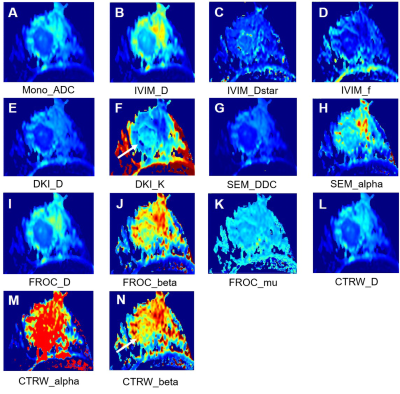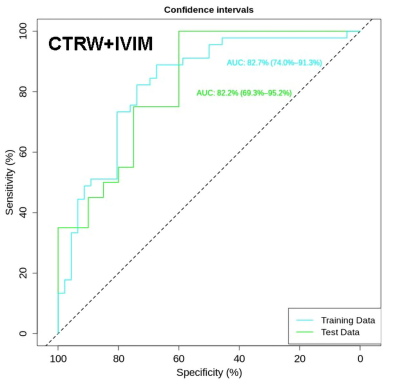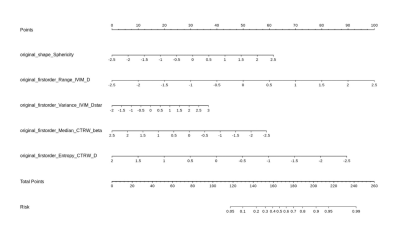4976
Evaluate Values of First-order Features based on Advanced DWI Models in Predicting the HER-2 Expression in Breast Invasive Ductal Cancer1Department of Radiology, The First Affiliated Hospital of China Medical University, Shenyang, China, 2MR Scientific Marketing, Siemens Healthineers Ltd., Beijing, China, 3Shanghai Key Laboratory of Magnetic Resonance, East China Normal University, Shanghai, China
Synopsis
In this study, we compared first-order features of six DWI models in predicting the HER-2 expression in breast invasive ductal carcinoma, including conventional mono-exponential model derived parameter ADC, IVIM derived parameters (D, Dstar, f), DKI derived parameters (D, K), SEM derived parameters (DDC, α), FROC derived parameters (D, β, mu), CTRW derived parameters (D, α, β), and a comprehensive diagnostic logistic regression model was established to improve the diagnostic performance. We found that CTRM and IVIM derived first-order features demonstrated the powerful performance, and their combination reached the highest performance. The finding has a great value in breast cancer treatment.
Backgrounds and Purpose
The level of HER-2 expression play an important role in making therapy schedule of breast invasive ductal carcinoma (IDC), through modulating angiogenesis via the induction of vascular endothelial growth factor[1]. HER-2 is also an important proto-oncogene, and the HER-2 positive expression is closely related to early metastasis, recurrence, and prognosis. Therefore, accurate prediction of HER-2 status is extremely important, based on which a personalized therapeutic schedule can be made to maximize the treatment benefits and to prolong the survival time. In these years, with the development of diffusion techniques, advanced diffusion models showed high diagnosis value for cancer, such as intro-voxel incoherent movement (IVIM), diffusion kurtosis imaging (DKI), stretched-exponential (SEM), fractional order calculus (FROC) and continuous-time random walk (CTRW) models. Unlike the DKI model reflecting non-Gaussian diffusion behavior, the SEM, FROC and CTRW models were more focuses on spatial heterogeneity of diffusion within voxel, which could be commonly found in high grade tumor[2]. As an initial experience, we intend to compare the first-order features of quantitative parameters from multiple DWI models in predicting the status of HER-2 expression in breast IDC. To evaluate the comprehensive diagnostic value of these models, a prediction models using whole-tumor first-order features was also established.Methods
From May 2020 to October 2021, a total of 131 women diagnosed with breast IDC by biopsy confirmed were consecutively enrolled. According to the HER-2 status confirmed with immunohistochemistry results, all the patients were divided into HER2-positive and HER2-negative groups. All the examinations underwent at a 3T MRI scanner ((MAGNETOM Skyra, Siemens Healthcare, Erlangen, Germany). The whole tumor’s volume was delineated based on a high b value images (b= 800s/mm2) using a software itk-snap (http://www.itksnap.org/). A T1 contrast-enhancement or T2WI images was referenced to improve the accuracy. First-order features were extracted using an open source tool named Pyradiomics (https://pyradiomics.readthedocs.io/). The parameter maps of all above 6 DWI models were calculated using a unified in-house developed software called BoDiLab, which is based on Python 3.7. In analysis, the normality and homogeneity of variance of the data were first analyzed, then an independent two sample t test or Mann Whitney U test was performed to recognize the features with significant difference (P<0.05). Then these selected features with significant difference were combined together using a logistic regression (LR) model (direction=both) to evaluate the comprehensive diagnostic performance. The analyses were completed using software based on Python and R languages.Result
1. Diagnostic performance of 6 advanced DWI models The CTRW exhibits higher AUCs (0.81) than other DWI models, including mono ADC (0.53, p=0.02), DKI (0.51, p=0.02), SEM (0.56, p=0.02), FROC (0.63, p=0.03), and with a comparable AUC with IVIM (0.72, p=0.44).2.Comprehensive diagnostic performance of the LR modelTwelve first-order features including 8 CTRW derived first-order features (5 from CTRW beta, 2 from CTRW alpha and 1 from CTRW D), 3 IVIM derived first-order features (IVIM D range, IVIM Dstar Variance, IVIM_f Kurtosis ) and 1 shape feature (Sphericity), show significant difference between the two subgroups (p<0.05). When combined CTRW and IVIM derived features, the comprehensive model LR reaches the highest diagnostic performance no matter in training or testing data set, with (AUC: 0.83 (95%CI: 0.74, 0.91) or 0.82 (95%CI:0.69, 0.95), sensitivity: 88.9% or 100%, specificity: 67.4% or 60.0%).
Discussion
Diffusion weighted imaging can reflect the mobility of water molecules in vivo and play a vital role in breast cancer prognosis evaluation and therapeutic effect evaluation. However, in the traditional mono-exponential model, the motion of water molecules is assumed to free diffusion without restriction, which is imprecise within an organ. In fact, the microenvironments in biological tissues are complicated, especially in cancer, which is a heterogeneity tumor. Therefore, diffusion in the human body is no longer governed by a Gaussian probability distribution, but a non-Gaussian distribution. Therefore, more sophisticated and more accurate models in reflecting diffusion movement in the human body were developed [3]. The CTRW model, an extension of the FROC diffusion model, focuses more on spatial heterogeneity of diffusion within voxel, which could be commonly found in high grade tumor[2]. Different from DKI, the CTRW reflects intravoxel diffusion heterogeneity in both time and space, thus could be a potential biomarker for changes of tissue complexity and microenvironment. IVIM model, which could allow separate estimation of microcirculation in the capillaries and molecular diffusion, also has been widely used in the diagnosis and treatment of tumors[4,5]. In this study, we found when combined CTRW and IVIM derived features, the comprehensive model LR reached the highest diagnostic performance, which may have a great potential in IDC treatment, such as making personalized therapeutic schedule, and so on. HER-2 expression increases angiogenesis and has the close relationship with prognosis. The finding of the comprehensive LR model may play a vital role in clinical practice.Conclusion
Advanced DWI model, CTRM and IVIM, derived first-order features demonstrate the powerful performance in predicting HER-2 expression for breast IDC. Especially, when combined CTRW and IVIM derived features together, the comprehensive model LR reaches the highest diagnostic, which may have a great potential in IDC of breast treatment, such as making personalized therapeutic schedule.Acknowledgements
no.References
1. Brown LF, Berse B, Jackman RW et al. Expression of vascular permeability factor (vascular endothelial growth factor) and its receptors in breast cancer. Hum Pathol. 1995; 26(1):86–91.
2. Karaman MM, Zhang JX, Xie KL, et al. Quartile histogram assessment of glioma malignancy using high b-value diffusion MRI with a continuous-time random-walk model. 2021;34(4):e4485
3. Iima M, Honda M, Sigmund EE, et al. Diffusion MRI of the breast: Current status and future directions. 2020;52(1):70-90
4. Iima M, Yano K, Kataoka M, et al. Quantitative Non-Gaussian Diffusion and Intravoxel Incoherent Motion Magnetic Resonance Imaging: differentiation of malignant and benign breast lesions. 2015;50: 205-211
5. You C, Li J, Zhi W, Chen Y, et al. The volumetric-tumour histogram-based analysis of intravoxel incoherent motion and non-Gaussian diffusion MRI: association with prognostic factors in HER2-positive breast cancer. 2019;17(1):182.
Figures




